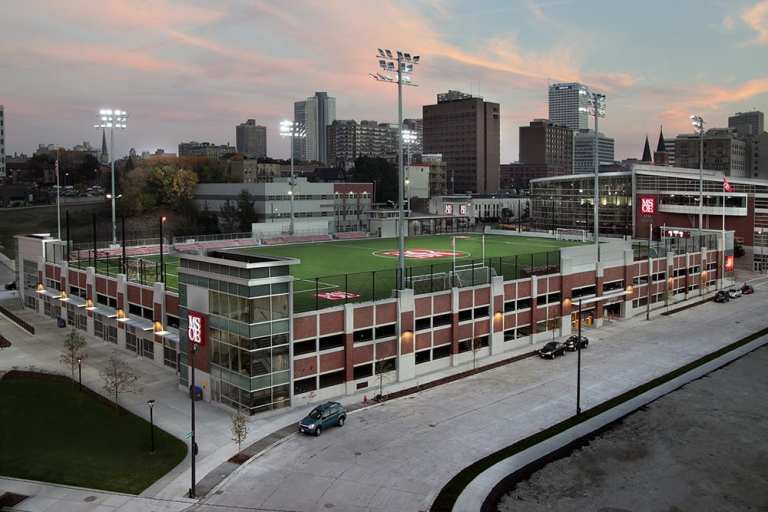Local Governments Move In On Retail Vacancies

It was supposed to be a thriving retail center in Milwaukee when it was built seven years ago. Right downtown, 10,000 square feet, enough room for five storefronts with a lacrosse and soccer field on top of the parking garage. But it never happened. No one ever leased from the development called Viets Field. In fact, last week, it was announced that the building would be the new home of the Milwaukee School of Engineering’s K-12 STEM program.
Issues with downtown spaces, malls and a general brick-and-mortar malaise have made cases like Viets Field a common occurrence. Many municipalities are looking to help by proposing new uses for vacant retail sites, including a citywide initiative in Fairfax, Virginia called Activate Fairfax, where the Department of Economic Initiative is soliciting requests for interest in an abandoned Container Store location. The DEO “seeks concepts and an operator to program the space to boost innovation and entrepreneurship, demonstrate creative placemaking and feature the Made in Fairfax Network. In addition, dynamic pop-up, cultural, artistic or community-oriented programming aligned with these goals will be encouraged to ensure that the space functions as a vibrant asset and experience for residents and visitors,” according to the statement.
It’s one approach to a growing retail vacancy issue that local governments are getting more aggressive in trying to solve. Two years ago, in Virginia, Fairfax County passed new zoning rules to support small-scale manufacturing by artisans making furniture, custom jewelry, textiles, baking, coffee roasting, vertical farming and other crafted products. The law opens up much more territory to these operations, which had only been permitted in areas zoned for industry. Most districts zoned commercial and mixed-use now welcome artisan production.
The change was designed not only to promote production and the jobs that result from it, but to enliven the areas in which these businesses are located. Craftmakers, according to the regulation, must sell as well as manufacture, with the retail side of the business-boosting commerce in mixed-use districts. The new regulations encourage interaction with the public by also mandating that the artisan businesses offer attractions such as tours and classes.
The most high-profile local interventions have happened Washington, D.C. and San Francisco. D.C. has hiked the normal commercial property tax rate on vacant property from between $1.65 and $1.85 for $100 in assessed value to $5 per $100. On March 3, San Francisco voters approved Proposition D, a property tax aimed at filling vacancies. Starting Jan. 1, 2021, the city will “tax owners or tenants that keep ground floor retail or other commercial space vacant in some areas of the city and to use these revenues to assist small business,” read the proposition.
Backers of the tax position it as a solution to the increasing amount of empty retail space in the city. It is expected to generate $5 million annually, with funds going to the city’s Small Business Assistance Fund.
Even smaller cities are opting for such taxes. Arlington, Massachusetts, passed a measure in 2017 that fines landlords $400 annually for each vacant storefront. In a year, 17 empty storefronts in Arlington Center, the historic business center of town, decreased by 11. And coincidentally, the city of Arlington, Virginia is doing the same.
“Intuition might tell you that if you cannot fill a space, owners would lower their rent to attract more tenants,” noted Arlington civic activist Nicole Merlene. “Oftentimes, this is not the case. Property owners will intentionally leave office and retail space vacant for a number of reasons. One is to wait for a large tenant to anchor the building, and avoid the build-out costs associated with leasing to smaller businesses along with the higher overhead needed to piecemeal tenants together. Another is that vacant space means lower taxes because of their low assessment.”
Mall leases for clothing retailers have suffered a 10 percent drop in the last few years. However, as Drew Myers, a real estate analyst at CoStar Group, pointed out in a CNN report, “medical clinics at malls have risen by almost 60 percent during the same period.”
Retailers and landlords galore are cashing in on the $3 trillion-plus healthcare industry by plugging medical facilities into empty spaces that threaten to turn once-thriving plazas into ghost malls. The New York-City-based CityMD is one healthcare company that bases its urgent care centers in malls and plazas.
Healthcare facilities are just one of the innovative tactics landlords are using as brick-and-mortar retail spaces are emptied by new waves of competition, not the least of which is online shopping. At the same time, local and regional governments are applying muscle in the form of taxes to push landlords into keeping their spaces tenanted.